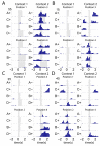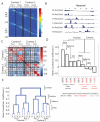Hippocampal representation of related and opposing memories develop within distinct, hierarchically organized neural schemas
- PMID: 24910078
- PMCID: PMC4082468
- DOI: 10.1016/j.neuron.2014.05.019
Hippocampal representation of related and opposing memories develop within distinct, hierarchically organized neural schemas
Abstract
Recent evidence suggests that the hippocampus may integrate overlapping memories into relational representations, or schemas, that link indirectly related events and support flexible memory expression. Here we explored the nature of hippocampal neural population representations for multiple features of events and the locations and contexts in which they occurred. Hippocampal networks developed hierarchical organizations of associated elements of related but separately acquired memories within a context, and distinct organizations for memories where the contexts differentiated object-reward associations. These findings reveal neural mechanisms for the development and organization of relational representations.
Copyright © 2014 Elsevier Inc. All rights reserved.
Figures





Comment in
-
Learning by example in the hippocampus.Neuron. 2014 Jul 2;83(1):8-10. doi: 10.1016/j.neuron.2014.06.013. Neuron. 2014. PMID: 24991951
References
Publication types
MeSH terms
Grants and funding
LinkOut - more resources
Full Text Sources
Other Literature Sources
Medical

